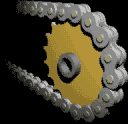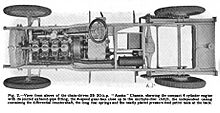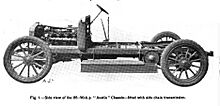Chain drive facts for kids
A chain drive is a clever way to move mechanical power from one place to another. Think of it like a strong, flexible rope made of metal links that helps machines work. It's often used to power the wheels of vehicles, especially bicycles and motorcycles. You can also find chain drives in many other machines, not just vehicles!
Most of the time, this power is moved by a special type of chain called a roller chain. This chain, also known as a drive chain or transmission chain, goes around a sprocket gear. The teeth of the sprocket fit perfectly into the holes in the chain's links. When the gear turns, it pulls the chain, sending power through the system. There's another type called the Morse chain, which has special "inverted teeth."
Sometimes, a chain drive simply rotates the chain to lift or drag heavy objects. In other cases, a second gear is added, and power is taken from this gear to make other parts of the machine move. While most drive chains are simple loops, they can also turn corners by using more than two gears. Gears that don't add or take power are called idler-wheels. By changing the size of the gears, you can change the gear ratio. For example, on a bicycle, one turn of the pedal gear makes the wheel gear turn more than once, helping you go faster.
Contents
History of Chain Drives
The idea of using chains to move things is very old! One of the earliest examples comes from the Greek engineer Philon of Byzantium in the 3rd century BC. He described a machine called the Polybolos, which used two flat-linked chains connected to a winding device. This system helped the machine automatically fire arrows. Even though these chains didn't transfer power continuously from one spinning part to another, they were an important step in the history of chain drives.
The first continuous chain drive, which could keep moving power, was shown in a Chinese book by Su Song (1020-1101 AD). He used this chain drive in his amazing astronomical clock tower in 1092 AD. This chain helped power the moving parts of his clock, including an armillary sphere and figurines that would strike gongs and drums to tell the time. Su Song's chain drive was powered by a water clock and a waterwheel, which acted like a big gear.
How Chain Drives Compare to Other Systems
Chain Drive vs. Belt Drive
Most chain drive systems use teeth to grip the chain and move it. This makes them very efficient, with less energy lost to friction compared to belt drive systems, which often rely on friction to work.
Chains can be made very strong, but they are usually heavier than belts. Belts are often made of rubber, plastic, or other flexible materials. While a heavier chain might seem like a disadvantage, the weight of the chain or belt usually doesn't make a huge difference to the overall weight of the machine.
One thing about roller chains is that their speed can change slightly as they go around the sprocket. This is called "chordal action." It's usually not a big problem for most machines. For example, many motorcycles use special rubber parts in their rear wheel hubs to help smooth out any small vibrations caused by this. Some newer toothed belts are designed to avoid this issue and keep a more constant speed.
Chains are often narrower than belts. This can make it easier to switch them between different-sized gears, like on a multi-speed bicycle with derailleurs. This lets you change your gear ratio easily. Both chains and belts can be used to move objects by attaching things like pockets or frames to them. Chains are often used to lift things vertically, while belts are great for moving things horizontally, like on conveyor belts. Sometimes, both systems are used together, like when a chain drive powers the rollers of a conveyor belt.
Chain Drive vs. Drive Shafts
Drive shafts are another common way to move mechanical power. They are often compared to chain drives, especially when designing motorcycles. Drive shafts tend to be very tough and reliable. However, they use bevel gears which create more friction than a chain drive. Because of this extra friction, most high-performance motorcycles use chain drives. Drive shafts are more common on motorcycles that are not designed for racing. Some motorcycles also use toothed-belt drives.
Chain Drives in Vehicles
Bicycles
The chain drive was a key feature that made the "safety bicycle" so popular in 1885. Before this, bicycles like the "penny-farthing" had one very large wheel and no chain. The safety bicycle had two equal-sized wheels and used a chain to transfer power from the pedals to the rear wheel. This design made bicycles much safer and easier to ride, and it's still a basic part of bicycle design today!
Automobiles
Many early cars also used chain drive systems. A common design involved a differential (a gear system that allows wheels to turn at different speeds) near the center of the car. This then sent power to the rear axle using roller chains. This design was quite simple and could handle the up-and-down movement of the rear wheels caused by the rear suspension.
The Frazer Nash car company was a big fan of chain drives. They used one chain for each gear, which allowed for very fast gear changes. This system was used in many racing cars in the 1920s and 1930s. One of the last popular cars to use a chain drive for its main power was the Honda S600 in the 1960s.
Motorcycles
Deciding between a chain drive, a belt drive, or a driveshaft is a big choice when designing a motorcycle. Almost all motorcycles use one of these three systems to send power to the wheels.
See also
- Bicycle chain
- Chain pump
- Chainsaw
- Gear
- Rolling mills






